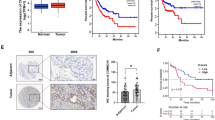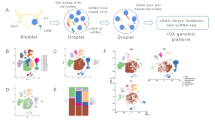Abstract
Gastric cancer (GC) remains a major disease of high morbidity and mortality worldwide despite advances in diagnosis and treatment. Ras homolog family member T1 (RHOT1) plays an important role in several cancers. Our study aimed to analyze RHOT1 expression, to assess the relationship between its expression and the prognosis of patients, and know the impact of RHOT1 on GC cells. The Cancer Genome Atlas (TCGA) RNA-seq data was used for gene expression analysis, survival and prognostic analysis. Nomograms were created to analyze the pathological factors of GC patients. RHOT1 expression was up-regulated by analyzed TCGA-Stomach adenocarcinoma (STAD) data and verified by Polymerase Chain Reaction (PCR) assay in GC tissues and cell lines. Furthermore, RHOT1 up-regulation was significantly associated with shorter survival of GC patients. At last, after silencing the expression of RHOT1 in AGS cell lines, we found that the proliferative ability of the cells was significantly reduced, the cell invasion ability was significantly inhibited, the cell migration ability was also significantly weakened, the cell cycle was arrested in the G0/G1 phase, and apoptosis was significantly increased. So RHOT1 could impact the apoptosis, proliferation, invasion, and migration behavior of GC cells. We trust RHOT1 has the potential to become a new oncogene biomarker for diagnosis and prognosis as well as a new therapeutic target in GC.





Similar content being viewed by others
Data availability
The original data in the manuscript were downloaded from the official websites of TCGA (https://portal.gdc.cancer.gov/) and GTEx (https://gtexportal.org/home/). TCGA and GTEx RNA-seq data in TPM format were obtained from UCSC XENA (https://xenabrowser.net/datapages/). Thanks to **antao Academic (www.xiantao.love) for providing the R language analysis platform.
Abbreviations
- ACC:
-
Adrenocortical carcinoma
- BLCA:
-
Bladder urothelial carcinoma
- BRCA:
-
Breast invasive carcinoma
- CESC:
-
Cervical squamous cell carcinoma and endocervical adenocarcinoma
- CHOL:
-
Cholangiocarcinoma
- COAD:
-
Colon adenocarcinoma
- DLBC:
-
Lymphoid neoplasm diffuse large B-cell lymphoma
- ESCA:
-
Esophageal carcinoma
- GBM:
-
Glioblastoma multiforme
- HNSC:
-
Head and neck squamous carcinoma
- KICH:
-
Kidney chromophobe
- KIRC:
-
Kidney renal clear cell carcinoma
- KIRP:
-
Kidney renal papillary cell carcinoma
- LAML:
-
Acute myeloid leukemia
- LGG:
-
Lower grade glioma
- LIHC:
-
Liver cancer
- LUAD:
-
Lung adenocarcinoma
- LUSC:
-
Lung squamous cell carcinoma
- MESO:
-
Mesothelioma
- OV:
-
Ovarian cancer
- PAAD:
-
Pancreatic cancer
- PCPG:
-
Pheochromocytoma & paraganglioma
- PRAD:
-
Prostate cancer
- READ:
-
Rectal cancer
- SARC:
-
Sarcoma
- SKCM:
-
Melanoma
- STAD:
-
Stomach cancer
- TGCT:
-
Testicular cancer
- THCA:
-
Thyroid cancer
- THYM:
-
Thymoma
- UCEC:
-
Endometrioid cancer
- UCS:
-
Uterine carcinosarcoma
- UVM:
-
Ocular melanomas
References
Sung, H., & Ferlay, J. (2021). Global Cancer Statistics 2020: GLOBOCAN Estimates of Incidence and Mortality Worldwide for 36 Cancers in 185 Countries. CA: A Cancer Journal for Clinicians, 71, 209–249.
Rezaei, Z., & Ranjbaran, J. (2022). Identification of early diagnostic biomarkers via WGCNA in gastric cancer. Biomedicine & Pharmacotherapy, 145, 112477.
Karimi, P., & Islami, F. (2014). Gastric cancer: Descriptive epidemiology, risk factors, screening, and prevention. Cancer Epidemiology, Biomarkers & Prevention, 23, 700–713.
Hoshi, H. (2020). Management of gastric adenocarcinoma for general surgeons. Surgical Clinics of North America, 100, 523–534.
Swan, R., & Miner, T. J. (2006). Current role of surgical therapy in gastric cancer. World Journal of Gastroenterology, 12, 372–379.
Fransson, A., & Ruusala, A. (2003). Atypical Rho GTPases have roles in mitochondrial homeostasis and apoptosis. Journal of Biological Chemistry, 278, 6495–6502.
Fransson, S., & Ruusala, A. (2006). The atypical Rho GTPases Miro-1 and Miro-2 have essential roles in mitochondrial trafficking. Biochemical and Biophysical Research Communications, 344, 500–510.
Macaskill, A. F., & Brickley, K. (2009). GTPase dependent recruitment of Grif-1 by Miro1 regulates mitochondrial trafficking in hippocampal neurons. Molecular and Cellular Neuroscience, 40, 301–312.
Wang, X., & Winter, D. (2011). PINK1 and Parkin target Miro for phosphorylation and degradation to arrest mitochondrial motility. Cell, 147, 893–906.
Jiang, H., & He, C. (2012). RhoT1 and Smad4 are correlated with lymph node metastasis and overall survival in pancreatic cancer. PLoS ONE, 7, e42234.
Li, Q., & Yao, L. (2015). Role of RHOT1 on migration and proliferation of pancreatic cancer. American Journal of Cancer Research, 5, 1460–1470.
Agarwal, E., & Altman, B. J. (2019). Myc regulation of a mitochondrial trafficking network mediates tumor cell invasion and metastasis. Molecular and Cellular Biology, 39, e00109-119.
Peng, Y. Y., & Sun, D. (2022). Hsa_circ_0005230 is up-regulated and promotes gastric cancer cell invasion and migration via regulating the miR-1299/RHOT1 axis. Bioengineered, 13, 5046–5063.
Guo, Q., & Zhao, L. (2023). Integrated pan-cancer analysis and experimental verification of the roles of tropomyosin 4 in gastric cancer. Frontiers in Immunology, 14, 1148056.
Shi, Y., & Wang, Y. (2023). Crosstalk of ferroptosis regulators and tumor immunity in pancreatic adenocarcinoma: Novel perspective to mRNA vaccines and personalized immunotherapy. Apoptosis, 28, 1423–1435.
Liu, J., & Lichtenberg, T. (2018). An integrated TCGA pan-cancer clinical data resource to drive high-quality survival outcome analytics. Cell, 173, 400–416.
Ji, X., & Lee, Y. J. (2022). Characterization of cell cycle and apoptosis in Chinese hamster ovary cell culture using flow cytometry for bioprocess monitoring. Biotechnology Progress, 38, e3211.
Fox, M. H. (1980). A model for the computer analysis of synchronous DNA distributions obtained by flow cytometry. Cytometry, 1, 71–77.
Conti, C. B., & Agnesi, S. (2023). Early Gastric cancer: update on prevention, diagnosis and treatment. International Journal of Environmental Research and Public Health, 20, 2149.
Huang, X., & Liu, Y. (2023). CHSY3 promotes proliferation and migration in gastric cancer and is associated with immune infiltration. Journal of Translational Medicine, 21, 474.
Yu, J., & Feng, H. (2023). VPS35 promotes cell proliferation via EGFR recycling and enhances EGFR inhibitors response in gastric cancer. eBioMedicine, 89, 104451.
Wang, R., & Huang, W. (2023). FLOT1 promotes gastric cancer progression and metastasis through BCAR1/ERK signaling. International Journal of Biological Sciences, 19, 5104–5119.
Lopez-Domenech, G., & Covill-Cooke, C. (2018). Miro proteins coordinate microtubule- and actin-dependent mitochondrial transport and distribution. EMBO Journal, 37, 321–336.
Safiulina, D., & Kuum, M. (2019). Miro proteins prime mitochondria for Parkin translocation and mitophagy. EMBO Journal, 38, e99384.
Weihofen, A., & Thomas, K. J. (2009). Pink1 forms a multiprotein complex with Miro and Milton, linking Pink1 function to mitochondrial trafficking. Biochemistry, 48, 2045–2052.
Grossmann, D., & Berenguer-Escuder, C. (2019). Mutations in RHOT1 disrupt endoplasmic reticulum-mitochondria contact sites interfering with calcium homeostasis and mitochondrial dynamics in Parkinson’s disease. Antioxidants & Redox Signaling, 31, 1213–1234.
Birsa, N., & Norkett, R. (2014). Lysine 27 ubiquitination of the mitochondrial transport protein Miro is dependent on serine 65 of the Parkin ubiquitin ligase. Journal of Biological Chemistry, 289, 14569–14582.
Hsieh, C. H., & Li, L. (2019). Miro1 marks Parkinson’s disease subset and miro1 reducer rescues neuron loss in Parkinson’s models. Cell Metabolism, 30, 1131–1140.
Schwarz, L., & Fitzgerald, J. C. (2022). Steady-state levels of miro1 linked to phosphorylation at serine 156 and mitochondrial respiration in dopaminergic neurons. Cells, 11, 1269.
Funding
This study was supported by the Doctoral Start-up Foundation of Liaoning Province, China (2022-BS-340); and the Supporting Project for Undergraduate Research project of Shenyang Medical College, China (20229010).
Author information
Authors and Affiliations
Corresponding author
Ethics declarations
Conflict of interest
The authors have no competing interests to declare that are relevant to the content of this article.
Ethical Approval
This is an observational study. The Shenyang Medical College Research Ethics Committee has confirmed that no ethical approval is required.
Additional information
Publisher's Note
Springer Nature remains neutral with regard to jurisdictional claims in published maps and institutional affiliations.
Supplementary Information
Below is the link to the electronic supplementary material.
Rights and permissions
Springer Nature or its licensor (e.g. a society or other partner) holds exclusive rights to this article under a publishing agreement with the author(s) or other rightsholder(s); author self-archiving of the accepted manuscript version of this article is solely governed by the terms of such publishing agreement and applicable law.
About this article
Cite this article
Kong, F., Yang, S., Shi, R. et al. The Up-Regulated Expression of Mitochondrial Membrane Molecule RHOT1 in Gastric Cancer Predicts the Prognosis of Patients and Promotes the Malignant Biological Behavior of Cells. Mol Biotechnol (2024). https://doi.org/10.1007/s12033-024-01107-8
Received:
Accepted:
Published:
DOI: https://doi.org/10.1007/s12033-024-01107-8




